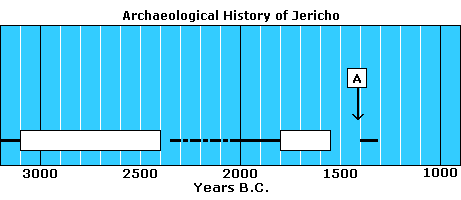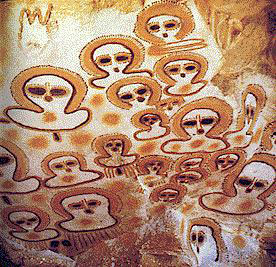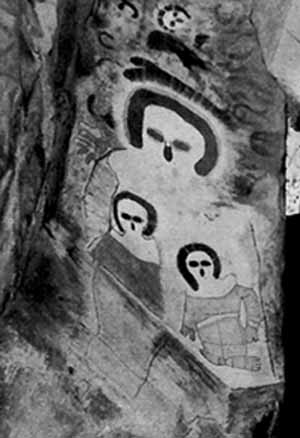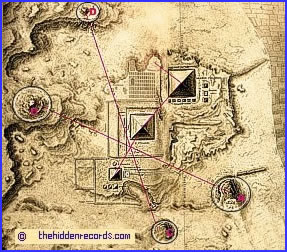 Egyptian Record
Egyptian Record"Indeed the face is pale; ... what the ancestors foretold has arrived...." -- Ipuwer, scribe,
Papyrus 1, date debated
"Indeed, the women are barren and none conceive." -- Ipuwer, scribe, Papyrus 1, date debated
"... pestilence is throughout the land, blood is everywhere, death is not lacking..." -- Ipuwer, scribe, Papyrus 2, date debated
"Indeed, many dead are buried in the river; the stream is a sepulcher and the place of embalmment has become a stream." -- Ipuwer, scribe, Papyrus 2, date debated
"Indeed, the land turns around as does a potter's wheel..." -- Ipuwer, scribe, Papyrus 2, date debated
"Indeed, the river is blood, yet men drink of it. Men shrink from human beings and thirst after water. Indeed, gates, columns and walls are burnt up, while the hall of the palace stands firm and endures. " -- Ipuwer, scribe, Papyrus 2, date debated
"Indeed, men are few, and he who places his brother in the ground is everywhere." -- Ipuwer, scribe, Papyrus 2, date debated
"Indeed, the desert is throughout the land, the nomes [districts] are laid waste, and barbarians from abroad have come to Egypt." -- Ipuwer, scribe, Papyrus 3, date debated
"Indeed, gold and lapis lazuli, silver and turquoise, carnelian and amethyst, Ibhet-stone and [. . .] are strung on the necks of maidservants." -- Ipuwer, scribe, Papyrus 3, date debated
"Indeed, hair [has fallen out] for everybody, and the man of rank can no longer be distinguished from him who is nobody." -- Ipuwer, scribe, Papyrus 4, date debated
"Indeed, the children of princes are dashed against walls...." -- Ipuwer, scribe, Papyrus 4 & 5, date debated
"Indeed, that has perished which yesterday was seen...." -- Ipuwer, scribe, Papyrus 4 & 5, date debated
"Indeed, all animals, their hearts weep; cattle moan because of the state of the land." -- Ipuwer, scribe, Papyrus 5, date debated
"Indeed, everywhere barley has perished ...." -- Ipuwer, scribe, Papyrus 6, date debated
"Behold, he whose hair is fallen out...." -- Ipuwer, scribe, Papyrus 8, date debated
"They cover their faces through fear of the morrow." -- Ipuwer, scribe, Papyrus 16, date debated
Hebrew Record"Thus saith the LORD, In this thou shalt know that I am the LORD: behold, I will smite with the rod that is in mine hand upon the waters which are in the river, and they shall be turned to blood. And the fish that is in the river shall die, and the river shall stink; and the Egyptians shall lothe to drink of the water of the river." -- Exodus 7:17-18
"And the fish that was in the river died; and the river stank, and the Egyptians could not drink of the water of the river; and there was blood throughout all the land of Egypt." -- Exodus 7:21
"And all the Egyptians digged round about the river for water to drink; for they could not drink of the water of the river." -- Exodus 7:24
"Behold, the hand of the LORD is upon thy cattle which is in the field...." -- Exodus 9:3
"And the LORD did that thing on the morrow, and all the cattle of Egypt died: but of the cattle of the children of Israel died not one." -- Exodus 9:6
"So there was hail [meteorites], and fire mingled with the hail, very grievous, such as there was none like it in all the land of Egypt since it became a nation. And the hail smote throughout all the land of Egypt all that was in the field, both man and beast; and the hail smote every herb of the field, and brake every tree of the field. Only in the land of Goshen, where the children of Israel were, was there no hail." -- Exodus 9:24-26
"And the flax and the barley was smitten...." -- Exodus 9:31
"And the children of Israel did according to the word of Moses; and they borrowed of the Egyptians jewels of silver, and jewels of gold, and raiment: And the LORD gave the people favour in the sight of the Egyptians, so that they lent unto them such things as they required. And they spoiled the Egyptians." -- Exodus 12:35-36
Scientific Commentary"Once the choice was made for the First Intermediate Period reasons were found to date it to the beginning of the period or even to the last years of Pepi II in the Old Kingdom." -- John van Seters, archaeologist, December 1964
"And these were not miracles seen just by a couple of people, these were events that have been seen by the entire nation. More than this, the population of Egypt was involved, and if we think a little more, these events could not have been even limited to the land of Egypt." -- Immanuel Velikovsky, polymath,
1966"No, if these things happened, really happened, they must be not only in Biblical source but also Egyptian source in the first place. Egyptian record. I looked for it; I found it. [An] Eyewitness [Ipuwer] describe[s] the catastrophe -- the very same plagues. Strange was to me that the translator of the papyrus [The Admonitions of Ipuwer] now in Holland in [the] museum of the University of Leiden and there since more than a hundred years, [the] papyrus translated in 1909 by Gardiner, he didn't even feel that the very same verses that he translate[d] in modern English he could read in the story of the plagues in King James Version. This was observed a case of some scotoma. But scotoma was with all of us. How is it that a book that was read more than any other book, translated into scores of languages, commented upon by many commentators through so many generations, but none of them was seeing or reading stone for stone and fire for fire?" -- Immanuel Velikovsky, polymath,
1966"Most Egyptologists agree that the Pyramid complex of King Neferkare Pepi II, the last major monument of the Old Kingdom, exhibits the same high quality of craftsmanship as its predecessors and gives no hint of the Dark Age soon to engulf all aspects of Egyptian civilization." -- Barbara Bell, archaeologist, 1971
"Pepi II ... appears to have had the longest reign in Egyptian history and perhaps in all history. The Turin Royal Canon credits him with upwards of ninety years. One version of the Epitome of Manetho indicates that he 'began to rule at the age of six and continued to a hundred.' Although modern scholars have questioned this, it remains to be disproved." -- William K. Simpson, historian, The Ancient Near East: A History, 1971
"Ipuwer had been understood by earlier scholars to be an attack by Ipuwer on a ruler, probably Pepi II." -- R. J. Williams, professor, 1981
"... research strongly suggests Moses and the Israelites went into bondage during the reign of Pharaoh Pepy II, the 'Pharaoh of the Oppression'" -- J.J. Williams, historian, Who Was the Pharaoh of the Exodus?, 1994
"One of the names in the family of Pepy II is an exact match to a name given in the Book of Jasher. This is the chief wife of Pepy II. In the Book of Jasher it states that the wife of Melol, the pharaoh of the oppression, was named Alparanith. The chief queen of Pepy II was named Neith (or Nith). This is very probably the same name and therefore the same person." -- J.J. Williams, historian, Who Was the Pharaoh of the Exodus?, 1994
"According to the Midrash, the Pharaoh of the Exodus was named Akidam and he had a short reign of four years. The Pharaoh who preceded him, whose death prompted Moses' return to Egypt (Exodus 2:23, 4:19), was named Malul. Malul, we are told, reigned from the age of six to the age of 100. Such a long reign - 94 years! - sounds fantastic, and many people would hesitate to take this Midrash literally. As it happens though, Egyptian records mention a Pharaoh who reigned for 94 years, and not only 94 years, but from the age of six to the age of 100! This Pharaoh was known in inscriptions as Pepi (or Phiops) II. The information regarding his reign is known both from the Egyptian historian-priest Manetho, writing in the 3rd century BCE, and from an ancient Egyptian papyrus called the Turin Royal Canon, which was only discovered in the last century." -- Brad Aronson, scholar, 1995

"Gerald E. Aardsma, Ph.D., has proposed an alternate solution, one that solves these problems and does justice to both biblical and secular scientific evidence. He has shown that the correct biblical chronology date for the Conquest is ca. 2400 B.C., not ca. 1400 B.C. By this solution, it is the ca. 2400 B.C. destruction at Jericho, shown in the charts above, which must be credited to Joshua." -- The Biblical Chronologist, 1996
"Ipuwer, an ancient Egyptian sage. He perhaps served as a treasury official during the last years of Pepi II Neferkare (reigned c. 2294 - c. 2200 BC)...." --
The New Encyclopaedia Britannica, Volume 6, 2002
"H. Frankfort, in an article published in 1926, brought together in support of this interpretation, archaeological evidence for many Syrian related button seals which first appear in Egypt, according to Frankfort, during the Sixth Dynasty about the time of Pepi II .... On the basis of the button seals, he concludes that the value of the Admonitions of Ipuwer (which was thought to refer to the time of Pepi II) as an 'historical document' was established." -- Thomas L. Thompson, historian, 2002
"The end of the reign of Pepi II led into the First Intermediate period...." -- Richard Lobban, historian,
Historical Dictionary of Ancient and Medieval Nubia, 2004
"There are many petroglyphs which depict ostriches and a few that depict giraffes. Butzer (1961) has used relative frequencies of the appearance of these animals in petroglyphs to gauge the changing climate. This evidence fits well with the three OK inscriptions, at least one of which is from the reign of Pepy II, which tell of digging wells (inscriptions DN28, ML01, ML12). While it is possible that these people could be simply pioneering a new route, it seems more likely that the old sources of water were drying up. Additional weight is given to the latter argument by a passage from a document known to Egyptologists as the 'Admonitions of Ipuwer,' which described conditions during the First Intermediate Period." -- Rusell D. Rothe, et al.,
Pharaonic Inscriptions From the Southern Eastern Desert of Egypt, Eisenbrauns, 2008
Scientific PublicationsFrankfort, H,
Egypt and Syria in the First Intermediate Period, The Journal of Egyptian Archaeology, Volume 12, Number 1/2, Pages 80-99, Apr 1926
Van Seters, J.,
A Date For The 'Admonitions' In The Second Intermediate Period, Journal of Egyptian Archaeology, Volume 50, Pages 12-23, 1964
Bell, B.,
The Dark Ages in Ancient History: I . The First Dark Age in Egypt, American Journal of Archaeology, Volume 75, Number 1, Pages 1-26, Jan 1971
Williams, R.J.,
The Sages of Ancient Egypt in Light of Recent Scholarship, Journal of the American Oriental Society, Volume 101, Number 1, Pages 1-19, 1981
Aardsma, G.E.,
A New Approach to the Chronology of Biblical History from Abraham to Samuel, 1993
What is the Missing Millenium Discovery?, The Biblical Chronologist, 1993
In 1990, Dr. Aardsma proposed a major adjustment to traditional biblical chronology. He proposed that the "480" of 1 Kings 6:1 was originally "1,480" but the Hebrew letters corresponding to the "one thousand" were lost at an early stage of copying.
This proposal is applied in the second time chart at left. The new biblical date for the Exodus becomes ca. 2450 B.C., and prior biblical events are similarly shifted to earlier times, by exactly 1000 years relative to traditional biblical chronology.
This change is radical, and at first unimaginable. However, as one begins to examine the archaeology at the new dates, the harmony between biblical and secular accounts is overwhelming. Egypt is struck by national disaster, effectively causing the collapse of the Old Kingdom at the end of the sixth dynasty. The trail of the Israelites in the desert at the time of the Exodus, and remains of their encampment dating to exactly this time period have been found. Both Jericho and Ai were destroyed ca. 2400 B.C., with destruction layers accurately fitting the biblical descriptions. The evidence that Dr. Aardsma's proposal is correct has become overwhelming and continues to mount.
This discovery and the ensuing research have resolved the conflicts between biblical and secular histories prior to the United Kingdom period. Dr. Aardsma's research has also led to many exciting discoveries surrounding early biblical events such as Noah's Flood. Conservative, Bible-believing scholarship today has an answer for those who claim that the Old Testament stories are mere fabrications. This discovery is of extreme significance to anyone who believes the Bible or studies biblical archaeology.
Williams, J.J., and Parry, C.,
Who Was the Pharaoh of the Exodus?, 1994
Aaronson, B.,
When Was the Exodus?, Jewish Action, 1995
Is Bryant Wood's Chronology of Jericho Valid?, The Biblical Chronologist, Volume 2, Number 3, 1996
DeMonocal, P.B.,
Cultural Responses to Climate Change During the Late Holocene, Science, Volume 292, Number 5517, Pages 667-673, Apr 2001
Thompson. T.L.,
The Historicity of the Patriarchal Narratives: The Quest for the Historical Abraham, 2002
Stanley, J-D., et al.,
Nile Flow Failure at the End of the Old Kingdom Egypt: Strontium Isotopic and Petrologic Evidence, Geoarchaeology, Volume 18, Issue 3, Pages 395-402, Feb 2003
Lobban, R.,
Historical Dictionary of Ancient and Medieval Nubia, 2004
Drysdale, R., at al.,
Late Holocene Drought Responsible for the Collapse of Old World Civilizations is Recorded in an Italian Cave Flowstone, Geology, Volume 34, Number 2, Pages 101-104, Feb 2006
Arz, H.W., et al.,
A Pronounced Dry Event Recorded Around 4.2 ka in Brine Sediments From the Northern Red Sea, Quaternary Research, Volume 66, Issue 3, Pages 432-441, Nov 2006
Rothe, R.D., et al.,
Pharaonic Inscriptions From the Southern Eastern Desert of Egypt, Eisenbrauns, 2008



















































